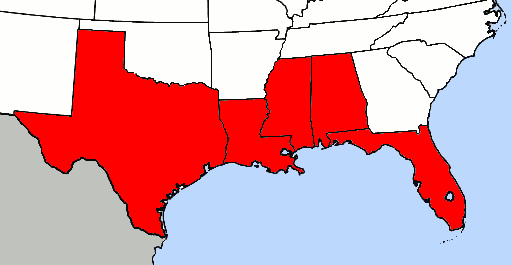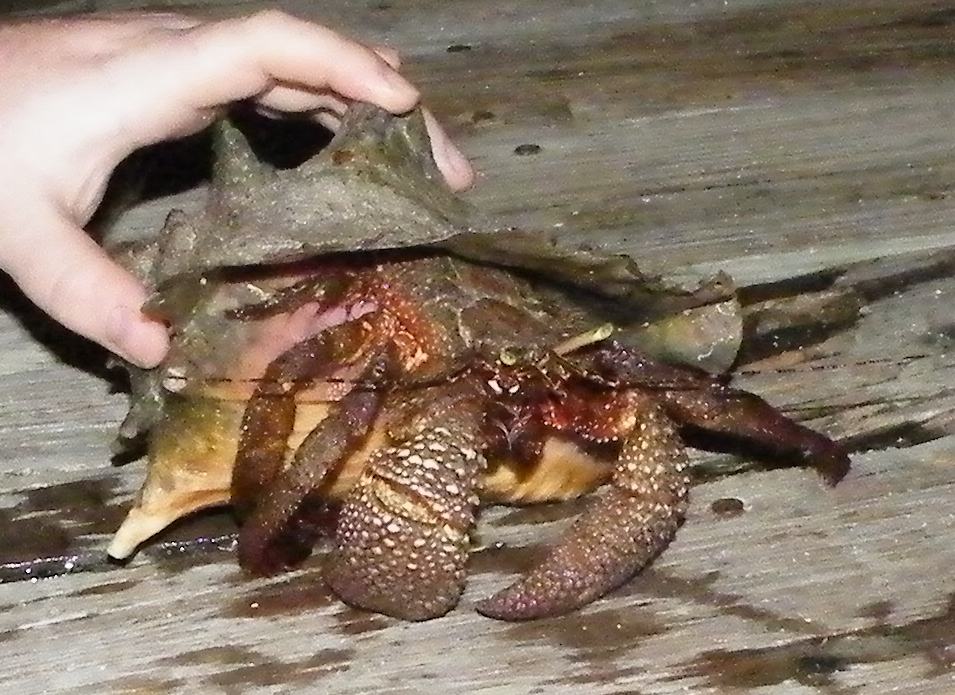|
Porcellana Sayana
''Porcellana sayana'' is a species of porcelain crab that lives in the western Atlantic Ocean, often as a commensal of hermit crabs. It is red with white spots, and has a characteristic bulge behind each claw. Distribution ''Porcellana sayana'' is found along the western coast of the Atlantic Ocean, from Cape Hatteras (United States) to Brazil, including the Gulf of Mexico and the Caribbean Sea. Description ''Porcellana sayana'' is long, and is red, with numerous whitish spots. It may be distinguished from other species by the form of the first pereiopod; the carpus (last segment before the claw) of that leg bears a lobe which projects forwards. It has a fringe of setae along the front of its claws, which it uses in filter feeding. Ecology ''Porcellana sayana'' lives in shallow water, at depths of up to , among rocks and oyster shells, or as a commensal of the hermit crabs '' Pagurus pollicaris'' and '' Petrochirus diogenes''. Like another porcelain crab, ''Petrolisthes galat ... [...More Info...] [...Related Items...] OR: [Wikipedia] [Google] [Baidu] |
Animal
Animals are multicellular, eukaryotic organisms in the Kingdom (biology), biological kingdom Animalia. With few exceptions, animals Heterotroph, consume organic material, Cellular respiration#Aerobic respiration, breathe oxygen, are Motility, able to move, can Sexual reproduction, reproduce sexually, and go through an ontogenetic stage in which their body consists of a hollow sphere of Cell (biology), cells, the blastula, during Embryogenesis, embryonic development. Over 1.5 million Extant taxon, living animal species have been Species description, described—of which around 1 million are Insecta, insects—but it has been estimated there are over 7 million animal species in total. Animals range in length from to . They have Ecology, complex interactions with each other and their environments, forming intricate food webs. The scientific study of animals is known as zoology. Most living animal species are in Bilateria, a clade whose members have a Symmetry in biology#Bilate ... [...More Info...] [...Related Items...] OR: [Wikipedia] [Google] [Baidu] |
Gulf States Marine Fisheries Commission
The Gulf States Marine Fisheries Commission (GSMFC) is an interstate compact among the five U.S. states that border the Gulf of Mexico: Alabama, Florida, Louisiana, Mississippi and Texas. Its purpose is to promote the conservation, development and utilization of the fishery resources of the gulf. The GSMFC was created on July 16, 1949, and is headquartered in Ocean Springs, Mississippi Ocean Springs is a city in Jackson County, Mississippi, United States, approximately east of Biloxi and west of Gautier. It is part of the Pascagoula, Mississippi Metropolitan Statistical Area. The population was 17,225 at the 2000 U.S. Census. .... References External linksOfficial website Fisheries agencies 1949 establishments in the United States Government agencies established in 1949 Alabama law Florida law Louisiana law Mississippi law Texas law United States interstate compacts {{US-org-stub ... [...More Info...] [...Related Items...] OR: [Wikipedia] [Google] [Baidu] |
Courier Dover Publications
Dover Publications, also known as Dover Books, is an American book publisher founded in 1941 by Hayward and Blanche Cirker. It primarily reissues books that are out of print from their original publishers. These are often, but not always, books in the public domain. The original published editions may be scarce or historically significant. Dover republishes these books, making them available at a significantly reduced cost. Classic reprints Dover reprints classic works of literature, classical sheet music, and public-domain images from the 18th and 19th centuries. Dover also publishes an extensive collection of mathematical, scientific, and engineering texts. It often targets its reprints at a niche market, such as woodworking. Starting in 2015, the company branched out into graphic novel reprints, overseen by Dover acquisitions editor and former comics writer and editor Drew Ford. Most Dover reprints are photo facsimiles of the originals, retaining the original pagination and t ... [...More Info...] [...Related Items...] OR: [Wikipedia] [Google] [Baidu] |
Common Name
In biology, a common name of a taxon or organism (also known as a vernacular name, English name, colloquial name, country name, popular name, or farmer's name) is a name that is based on the normal language of everyday life; and is often contrasted with the scientific name for the same organism, which is Latinized. A common name is sometimes frequently used, but that is not always the case. In chemistry, IUPAC defines a common name as one that, although it unambiguously defines a chemical, does not follow the current systematic naming convention, such as acetone, systematically 2-propanone, while a vernacular name describes one used in a lab, trade or industry that does not unambiguously describe a single chemical, such as copper sulfate, which may refer to either copper(I) sulfate or copper(II) sulfate. Sometimes common names are created by authorities on one particular subject, in an attempt to make it possible for members of the general public (including such interested par ... [...More Info...] [...Related Items...] OR: [Wikipedia] [Google] [Baidu] |
Alpha Taxonomy
In biology, taxonomy () is the science, scientific study of naming, defining (Circumscription (taxonomy), circumscribing) and classifying groups of biological organisms based on shared characteristics. Organisms are grouped into taxon, taxa (singular: taxon) and these groups are given a taxonomic rank; groups of a given rank can be aggregated to form a more inclusive group of higher rank, thus creating a taxonomic hierarchy. The principal ranks in modern use are domain (biology), domain, kingdom (biology), kingdom, phylum (''division'' is sometimes used in botany in place of ''phylum''), class (biology), class, order (biology), order, family (biology), family, genus, and species. The Swedish botanist Carl Linnaeus is regarded as the founder of the current system of taxonomy, as he developed a ranked system known as Linnaean taxonomy for categorizing organisms and binomial nomenclature for naming organisms. With advances in the theory, data and analytical technology of biologica ... [...More Info...] [...Related Items...] OR: [Wikipedia] [Google] [Baidu] |
University Of South Carolina Press
The University of South Carolina Press is an academic publisher associated with the University of South Carolina. It was founded in 1944. By the early 1990s, the press had published several surveys of women's writing in the southern United States in a series called Women's Diaries and Letters of the Nineteenth Century South, edited by Carol Bleser. According to Casey Clabough, the quality of its list of authors and book design Book design is the art of incorporating the content, style, format, design, and sequence of the various components and elements of a book into a coherent unit. In the words of renowned typographer Jan Tschichold (1902–1974), book design, "though ... became substantially better between the 2000s and 2010s. References 1944 establishments in South Carolina Academic publishing companies University of South Carolina {{SouthCarolina-stub ... [...More Info...] [...Related Items...] OR: [Wikipedia] [Google] [Baidu] |
Aporobopyrus Curtatus
Aporobopyrus is a genus of Isopoda parasites, in the family Family (from la, familia) is a group of people related either by consanguinity (by recognized birth) or affinity (by marriage or other relationship). The purpose of the family is to maintain the well-being of its members and of society. Idea ... Bopyridae, that contains the following 20 species: *'' Aporobopyrus aduliticus'' Nobili, 1906 *'' Aporobopyrus bonairensis'' Markham, 1988 *'' Aporobopyrus bourdonis'' Markham, 2008 *'' Aporobopyrus calypso'' Bourdon, 1976 *'' Aporobopyrus collardi'' Adkison, 1988 *'' Aporobopyrus curtatus'' Richardson, 1904 *'' Aporobopyrus dollfusi'' Bourdon, 1976 *'' Aporobopyrus enosteoidis'' Markham, 1982 *'' Aporobopyrus galleonus'' Williams & Madad, 2010 *'' Aporobopyrus gracilis'' Nierstrasz & Brender à Brandis, 1929 *'' Aporobopyrus megacephalon'' Nierstrasz & Brender à Brandis, 1929 *'' Aporobopyrus muguensis'' Shiino, 1964 *'' Aporobopyrus orientalis'' Shiino, 1933 *'' Apo ... [...More Info...] [...Related Items...] OR: [Wikipedia] [Google] [Baidu] |
Bopyridae
The Bopyridae are a family of isopod crustaceans in the suborder Cymothoida. There are 1223 individual species contained in this family. Members of the family are ectoparasites of crabs and shrimp. They live in the gill cavities or under the carapace A carapace is a Dorsum (biology), dorsal (upper) section of the exoskeleton or shell in a number of animal groups, including arthropods, such as crustaceans and arachnids, as well as vertebrates, such as turtles and tortoises. In turtles and tor ... where they cause a noticeable swelling. Fossil crustaceans have occasionally been observed to have a similar characteristic bulge. Genera References {{Taxonbar, from=Q2910574 Cymothoida Taxa named by Constantine Samuel Rafinesque Crustacean families ... [...More Info...] [...Related Items...] OR: [Wikipedia] [Google] [Baidu] |
Petrolisthes Galathinus
''Petrolisthes'' is a genus of marine porcelain crabs, containing these extant species: *'' Petrolisthes aegyptiacus'' Werding & Hiller, 2007 *'' Petrolisthes agassizii'' Faxon, 1893 *''Petrolisthes amoenus'' (Guérin-Méneville, 1855) *'' Petrolisthes armatus'' (Gibbes, 1850) *'' Petrolisthes artifrons'' Haig, 1960 *''Petrolisthes bifidus'' Werding & Hiller, 2004 *''Petrolisthes bispinosus'' Borradaile, 1900 *''Petrolisthes bolivarensis'' Werding & Kraus, 2003 *'' Petrolisthes borradailei'' Kropp, 1984 *'' Petrolisthes boscii'' (Audouin, 1826) *''Petrolisthes brachycarpus'' Sivertsen, 1933 *''Petrolisthes cabrilloi'' Glassell, 1945 *'' Petrolisthes caribensis'' Werding, 1983 *'' Petrolisthes carinipes'' (Heller, 1861) *''Petrolisthes celebesensis'' Haig, 1981 *''Petrolisthes cinctipes'' (J. W. Randall, 1840) *''Petrolisthes coccineus'' (Owen, 1839) *''Petrolisthes cocoensis'' Haig, 1960 *''Petrolisthes columbiensis'' Werding, 1983 *''Petrolisthes crenulatus'' Lockington, 1878 *' ... [...More Info...] [...Related Items...] OR: [Wikipedia] [Google] [Baidu] |
Petrochirus Diogenes
''Petrochirus diogenes'' is a giant marine hermit crab. This species lives in the Caribbean Sea, and often inhabits conch shells. This species of hermit crab is large enough that it can inhabit a fully grown shell of ''Lobatus gigas''. It will attack and eat a conch, thus obtaining a meal and a shell. It was originally described by Carl Linnaeus as ''Cancer diogenes''; the specific epithet honours Diogenes of Sinope Diogenes ( ; grc, Διογένης, Diogénēs ), also known as Diogenes the Cynic (, ) or Diogenes of Sinope, was a Greek philosopher and one of the founders of Cynicism (philosophy). He was born in Sinope, an Ionian colony on the Black Sea .... References Hermit crabs Crustaceans of the Atlantic Ocean Crustaceans described in 1758 Taxa named by Carl Linnaeus Diogenes {{Decapoda-stub ... [...More Info...] [...Related Items...] OR: [Wikipedia] [Google] [Baidu] |
Pagurus Pollicaris
''Pagurus pollicaris'' is a hermit crab commonly found along the Atlantic coast of North America from New Brunswick to the Gulf of Mexico. It is known by a number of common names, including ''gray hermit crab'', ''flat-clawed hermit crab'', ''flatclaw hermit crab'', ''shield hermit crab'', ''thumb-clawed hermit crab'', ''broad-clawed hermit crab'', and ''warty hermit crab''. ''P. pollicaris'' inhabits the shells of shark eye snails and whelks. It grows to a length of and a width of . The shell is often shared by the commensal zebra flatworm ('' Stylochus ellipticus''). The diet of the flat-clawed hermit crab comprises organic matter, algae, and sometimes other hermit crabs. Fish Fish are aquatic, craniate, gill-bearing animals that lack limbs with digits. Included in this definition are the living hagfish, lampreys, and cartilaginous and bony fish as well as various extinct related groups. Approximately 95% of ... are the most important predators of this specie ... [...More Info...] [...Related Items...] OR: [Wikipedia] [Google] [Baidu] |
Filter Feeding
Filter feeders are a sub-group of suspension feeding animals that feed by straining suspended matter and food particles from water, typically by passing the water over a specialized filtering structure. Some animals that use this method of feeding are clams, krill, sponges, baleen whales, and many fish (including some sharks). Some birds, such as flamingos and certain species of duck, are also filter feeders. Filter feeders can play an important role in clarifying water, and are therefore considered ecosystem engineers. They are also important in bioaccumulation and, as a result, as indicator organisms. Fish Most forage fish are filter feeders. For example, the Atlantic menhaden, a type of herring, lives on plankton caught in midwater. Adult menhaden can filter up to four gallons of water a minute and play an important role in clarifying ocean water. They are also a natural check to the deadly red tide. Extensive article on the role of menhaden in the ecosystem and possible r ... [...More Info...] [...Related Items...] OR: [Wikipedia] [Google] [Baidu] |





